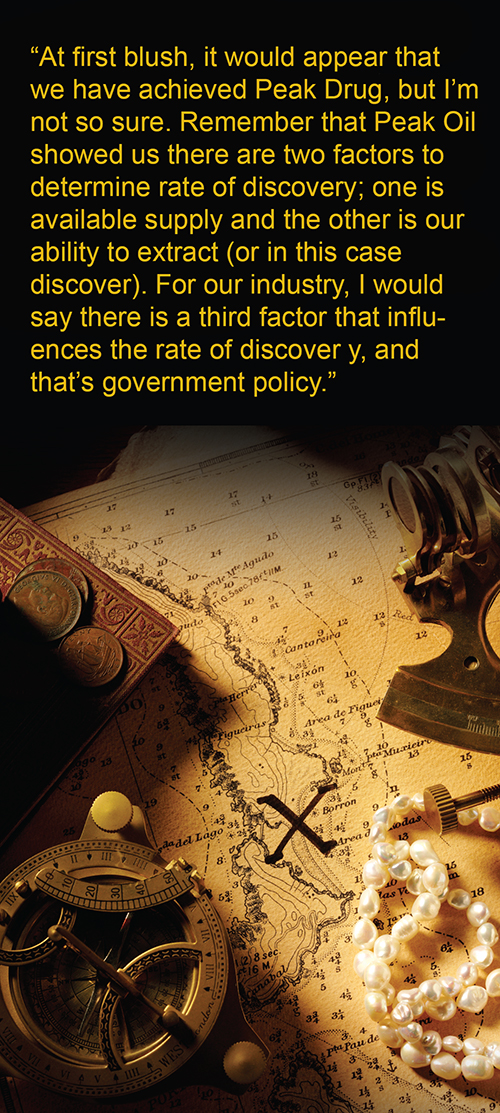MANAGEMENT INSIGHT - Peak Drugs: Have We Passed the Peak of New Drug Discoveries? Are the Best Days Behind Us?
WHATEVER HAPPENED TO PEAK OIL?
Since the 1970s, we have been told with varying degrees of certainty that we are about to run out of oil. We are at — or past — Peak Oil; Peak Oil being that moment when the rate of oil production is at its maximum. It’s all downhill from there.
Imagine you have a room full of pistachios, writes Russ Roberts in the book Invisible Heart.
You adore pistachios and never tire of eating them. There is only one rule: each time you eat a pistachio you must discard the shell back into the room full of pistachios. Over time, it will be harder and harder to find a nut from among the discarded shells. Eventually, the effort of finding nuts amongst all those shells will become too much and you’ll stop looking, tragically leaving some pistachios uneaten. What’s important to understand about this illustration is that you never ran out of pistachios. There are more. It’s just that as supplies declined what’s left became increasingly hard to get at.
Oil is like that. The people who told us that we were running out of oil were accurately reflecting the fact that conventional oil supplies were and are declining. But Peak Oil is not defined by the vastness of supply; it’s defined by the rate of production. Like pistachios, we love our oil, so we looked for easier ways to get it. As supplies tightened and prices rise, producers are strongly incentivized to work harder and improve the processes of extracting oil from unlikely and inconvenient sources.
So while total reserves of conventional oil are limited, Peak Oil — the maximum rate of production — hasn’t been breached. The advent of fracking (hydraulic fracturing) has increased the means of producing unconventional oil and made up for and even exceeded the rate of production of conventional oil.
The peak concept can easily be extended beyond oil. Dinosaur fossils that are lying about waiting to be discovered are also in finite supply. How many dinosaurs are still out there? How many genera? Through statistics and sampling, scientists in 2006 came to the conclusion that we have about two hundred years of discovery ahead of us.
The first dinosaur was discovered in 1824, and in the following 150 years, we discovered about one new genus a year. The rate of discovery has ramped up to about fifteen genera a year since then, and shows no signs of declining, indicating that we haven’t yet reached Peak Dinosaur discovery. As of 2006, we had discovered 29% of 1850 genera expected. By 2037, we should have uncovered about half of the supply of dinosaurs, and by 2200, we should be about done.
PEAK BURGER
Peak Burger, it appears, has been breached. Since the birth of McDonalds, and perhaps earlier, the rate of burger consumption has been steadily increasing in America, but Business Week now claims the rate of consumption of burgers in America is on the decline. McDonalds opened in 1955 and grew to 700 outlets within a decade. In 1983, there were 6000 restaurants and the rate of openings was 360 a year for 20 more years, according to “Obesity and fast food restaurant 7.0”, via Wikimedia Commons. In 2013, the net number of restaurants grew by only 121. Wendy’s, KFC, Burger King, and others show similar rates of decline.
PEAK ECONOMIST
If you want to get your name in The New York Times, become an economist. Before the Great Depression, economists weren’t really a thing. In fact, priests were once more quoted than social scientists of any kind. But there’s nothing like a financial calamity to send the public running to economists for advice and forecasting. Each ensuing recession has strengthened the trend, and today, according to The New York Times Chronicle Tool, economists are totally in.
Measured by mentions in The New York Times, the fortunes of economists have risen and fallen throughout the years, but are now in a solid lead, followed by historians, psychologists, sociologists, anthropologists, and lastly, the much sidelined demographer. Economists show no evidence of having peaked.
PEAK SELFIE
Has the rate of production of selfies peaked? When will people get tired of commemorating every good latte and new pair of shoes with a selfie? I could go on. Have we reached Peak Superhero movie? Peak Beard? Peak Tattoo?
PEAK DRUG
Have we reached the peak of new drug discoveries? There are many ways we could measure drug discovery, but FDA approvals seems like a good place to start. It’s not as easy as you’d believe to calculate the number of New Molecular Entities (NMEs) approved by the FDA each year. Even the FDA’s own website doesn’t provide a good overview, in part due to the removal of drugs no longer on the market. But according to, “An Overview of FDA-Approved New Molecular Entities (NMEs): 1827-2013,” published in Drug Discovery Today by Michael Kinch, Austin Haynesworth, Sarah Kinch, and Denton Hoyer, 1,453 drugs have obtained FDA approval as of 31 December 2013.
Now let’s zero in on the pace of those approvals. Very few drugs received approval prior to the creation of the FDA in 1938, most notably Merck’s morphine in 1827 and aspirin in 1899. Until 1950, NMEs averaged around four per year, but that number took off after that. The FDA began routinely approving at least 10 NMEs per year into the 1980s, when that number doubled to 20 a year. The peak rate of approvals was achieved in 1997 when the agency approved a stunning 55 NMEs, according to Kinch, Haynesworth, Kinch, and Hoyer — a number that the agency has not since even approached.
At first blush, it would appear that we have achieved Peak Drug, but I’m not so sure. Remember that Peak Oil showed us there are two factors to determine rate of discovery; one is available supply and the other is our ability to extract (or in this case discover). For our industry, I would say there is a third factor that influences the rate of discovery, and that’s government policy. All of these factors have been contributing to the increase in FDA approvals we’ve seen since the beginning of this decade, including the 41 drugs approved in 2014. We’re not there yet, but 55 is in our sights, and our pace of discovery is accelerating, not declining. Many of the reasons for this acceleration could be in the early stages, meaning there may be a rich field of drug discovery that we have yet to tap.
INCREASING DISCOVERY THROUGH REPURPOSING & EXPANDING USES
NMEs and NCEs (new chemical entities) are not as finite an entity as oil. New entities are constantly being discovered, but there’s also a grey area of discovery that Peak Oil, Peak Burger, and those other peaks don’t have to contend with, and that’s repurposing. You can’t repurpose a gallon of oil; it’s a fuel and that’s its only significant purpose. The thought of repurposing a burger or a tattoo or a dinosaur fossil is ludicrous, to say the least. But in our industry, we can expand our reservoir of new drugs through repurposing and expanding use.
The most celebrated example of repurposing is thalidomide. Tragically, its first and most unfortunate purpose was as a sedative and remedy for morning sickness. It was because of its sedative effects, however, that thalidomide stumbled on its first true calling, entirely by accident, according to the book Dark Remedy, which recounts the story of a physician who prescribed the only sedative in the hospital pharmacy closet to an ailing leprosy patient. The effect on the patient’s condition was as dramatic as it was unexpected. A new treatment was discovered. Thalidomide has since been repurposed yet again as an accepted treatment for multiple myeloma when used in combination with dexamethasone.
Other drugs receive new life through more gradual market expansion. A drug may be developed for a particular type of cancer, and later approved for a second and then a third type of cancer.
Eflornithine is an ornithine decarboxylase inhibitor that started life as possible treatment for cancer, but took a sharp turn in early research when it showed very positive results for trypanosomiasis, otherwise known as sleeping sickness. Later it was discovered to slow the growth of unwanted facial hair, leading to a rather embarrassing moment in the drug’s history when it was readily available as a cream for first-world cosmetic applications, but not as a tablet for dying Africans. Aventis eventually took control of the matter, teaming up with the World Health Organization (WHO) to produce a compound that it then gave to the WHO and to Doctors Without Borders.
INCREASING DISCOVERY THROUGH HUMAN INGENUITY
Human ingenuity is also increasing the size of the drug discovery pool. You may wonder why I mention this at all as it is patently obvious that drugs don’t discover themselves. But there was a time when drug discovery was rather easy, and drug entities were discovered and developed much like a miner in the Old West might pan for gold in a California creek. That’s an oversimplification, but not by much. Now, with gene therapy, nanotechnology, and so many different, previously unimaginable ways of treating disease, we have increased the pool yet again. A chemical entity that failed a cancer trial a decade ago, for example, may now be tried and proven effective in the presence of certain genetic traits. And so the pool expands again.
INCREASING DISCOVERY THROUGH GOVERNMENT POLICY
I’ve mentioned this in recent articles, and it is fitting to mention it again here. New government policy has significantly opened the tap for drug discovery. Until recently, drug development focused heavily on the hunt for blockbusters, but policies such as including 7 years of patent protection for certain orphan drugs, vouchers for orphan drug development, tax incentives, and more, have set the orphan drug category on fire. At Xcelience, 40% of the drug candidates in our facility right now could be classified as orphan drugs, compared to — let me think — approximately none 6 years ago.
The implications of government stimulation for orphan drug discovery go well beyond the discovery of orphan drugs. When everyone was chasing only the large population diseases, many promising NMEs were set aside as not worth pursuing. Now, a greater percentage of molecules are deemed worthy of further testing, a fact which is bound to significantly improve the odds of discoveries of all kinds.
PEAK DRUGS, ACHIEVED?
The pool of NMEs and NCEs may be finite, but because of repurposing, expanding uses, and new applications arising from medical advancements like the decoding of the human genome, it is now nearly impossible to imagine where the hard edges of that pool of entities may be. Wherever those borders might be, it’s clear that the supply of new drugs to be discovered remains vast. More importantly, our rate of extraction from that pool, much like fracking from an oil reserve, is pushing our rate of discovery rapidly upward. While we have yet to surpass the 1996 FDA record of 55 approvals, the current environment is ripe to produce an explosion of drug approvals within the next decade. Only then will we know for sure if Peak Drug has been breached, or is still in our future. Peak Selfie, on the other hand, may still be ahead of us!
To view this issue and all back issues online, please visit www.drug-dev.com.

Derek G. Hennecke, President & CEO, Xcelience
Total Page Views: 1341


















